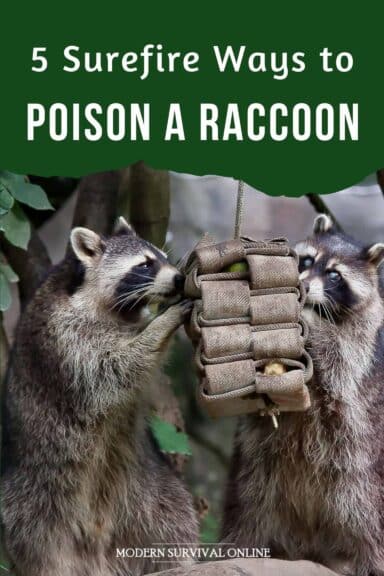Raccoons are adorable and charming, but only when you’re looking at them on the Internet or over in your neighbor’s yard.

Raccoons that get on your property are invariably going to be a giant pain in the you-know-where. They are experts at breaking into trash and stored feed, can be aggressive, and if they get into your house to nest, you’re going to have a disaster on your hands.
Raccoons can sometimes be driven away, occasionally be caught, or sometimes kept out. But much of the time, they’re just too clever and too agile to get rid of using these methods.
Sometimes you’ve got to resort to lethal intervention. If that’s the case, poison may be one of your best and most reliable tools, but it’s a capricious one that you must use with great care…
If you think you’re up for the job, keep reading and I’ll tell you about 5 surefire ways to poison a raccoon below.
Before You Begin
Before we get started, here’s the obligatory safety brief. Don’t assume that raccoons can be ruthlessly eliminated like the pests that they are.
They might be protected where you live at the local or state level. If you are allowed to get rid of raccoons as pests, it might only be under certain circumstances or at certain times of the year.
Similarly, there might be prohibitions on what you can use to actually dispatch them. Poisons might not be acceptable at all. It just depends, and you must not assume because these laws often entail serious misdemeanor or even felony charges for breaking them.
Only once you have ascertained the full letter of the law and your responsibilities should you proceed.
Always Use Maximum Caution When Employing Poisons!
I hope this part will be obvious, but experience has taught me time and time again that not everyone will be responsible with poisons. It’s imperative that you use maximum caution and discretion if you’re relying on poison to dispatch a raccoon or any other animal.
For starters, death by poison, no matter what kind, is always hideous and often slow. Are you prepared to inflict that on a raccoon? Consider also that poison doesn’t kill instantly no matter how deadly it is.
If a raccoon is fatally poisoned but crawls off into or under your house somewhere, the corpse will soon start stinking to high heaven and that can make for a difficult or impossible removal.
Lastly and most importantly, poison is a highly indiscriminate killer. Because we can only rely on it through ingestion, typically by tainting attractive food with it, other animals like dogs and cats could likewise be fatally poisoned.
Smaller animals like squirrels, rats, and the like get poisoned and then die, and scavengers that eat them might then be poisoned. A chain reaction of death stretching on and off, all because you were careless or hasty.
Think carefully about what sort of bait you will use and where you will place it so that raccoons can get to it, but other animals cannot or are less likely to.
With all of that in mind, it’s time to get down to the poisons…
Warfarin, Flocoumafen, Brodifacoum, and Related Agents
You might recognize a couple of these poisons, but these and many others all have one thing in common: they are anticoagulants.
They work by reducing and eventually eliminating the clotting factor in the blood, typically accomplished by disrupting the integration and processing of vitamin K.
Whatever kind they are, these are widespread poisons that are used throughout the pest control industry today both at the professional and the consumer level.
Although effective, cheap, and easy to implement, they are very slow-acting with all but the largest and most powerful doses causing death anywhere from a week to 2 weeks after the poor animal eats the stuff.
Depending on the product, or the way that you apply it, a single dose might do it, or you might let the targeted animal eat from a tainted source repeatedly. It rarely results in a gory or heinous death, but it is a slow and miserable one…
If you are going this route, know that all poisons in the anticoagulant group are notorious for causing serious collateral damage to other animals. Rodents routinely fall victim to this stuff as designed no matter how it is deployed, and that ends up killing cats, birds of prey, and larger mammals that eat the mice.
A raccoon that dies from it would certainly be scavenged by foxes, crows, vultures, and the like, so try to confirm the kill and dispose of the body safely after death.
Bromethalin
Bromethalin is distinct from the anticoagulant group of poisons above because it is neurotoxic, and potently so.
It is again found in widespread use against rodents, and is highly effective against larger mammals in correspondingly larger doses, including humans, so handle and deploy this stuff with care!
The function of bromethalin is that it sharply decreases ATP synthesis after ingestion once it is metabolized.
A decrease in ATP levels means that various enzymes become dormant, and when these enzymes go dormant, it causes fluid to build up around and damage the nervous system tissues with pressure. Eventually, it results in severe disruption of bodily function and paralysis followed by death.
This is another gruesome poison, and one that commonly affects animals besides the target. When a significant dose is ingested, bromethalin causes severe abdominal cramping, explosive diarrhea, seizures, and profound sensitivity to light and noise.
Know that in the case of accidental poisoning, prompt medical intervention can neutralize the poison and minimize damage to pets and people, so keep an eye out for all of those symptoms and your own pets or other animals if you are deploying it around the property.
Strychnine
A well-known poison with a particularly dark reputation since it has enjoyed dual use in assassination and espionage, strychnine has enjoyed far more use as a common pesticide.
A long time ago, microdoses of strychnine were also used in medical settings to help people who had lost control of their muscles or could not achieve full contraction of the same.
Strychnine is a versatile poison because it can kill if ingested, but also if absorbed through mucous membranes or even inhaled.
This stuff is incredibly potent and takes effect quickly. Ingestion may result in symptoms as little as 5 minutes, but more commonly 20 to 30 minutes.
Once it starts to take effect, the poisoned animal will experience twitching that will progress to seizures and eventually grand mal muscular contractions. This is often accompanied by profuse drooling and sometimes foaming at the mouth. Death, when it occurs, is typically via asphyxiation because the respiratory muscles become paralyzed.
Prior to death, a heinous type of rigor mortis sets in where major muscle groups of the torso and limbs become rigidly locked in place. I warn you, even compared to other poisons we have discussed, death by strychnine is terribly ugly.
Largely fallen out of favor, strychnine is still produced and sold as poison for use against large rodents and larger vertebrate pests. Coyotes, foxes, moles, groundhogs, and sometimes Norway rats are common intended targets.
Interestingly, some mammals show immunity or extraordinary resistance to the effects of strychnine.
Horses are the most well-known example, and this means it might have genuine special utility if you keep horses yourself and are dealing with raccoons around the barn or shed.
Vitamin D3
No, you aren’t seeing things. Vitamin D3 can actually be a ferociously potent poison in high doses. And yes, it’s the very same D3 that we get when we go out in the sun or take as part of a multivitamin. No kidding!
You’ll often see vitamin D3 referred to in the pest control setting as cholecalciferol to prevent confusion or people just getting the wrong idea. But make no mistake; vitamin D3 is incredibly dangerous to all mammalian life in high concentrations.
It also kills in a particularly horrible way. Vitamin D3 will cause the progressive calcification of soft tissues throughout an animal’s body once it reaches toxic levels.
If you know anything about the process of calcification, you already know that it is very literally what petrification is. This is some evil voodoo stuff, but it’s entirely real!
And don’t think this is some peculiar homebrew methodology either: vitamin D3 is used around the world as species-specific poison baits, so the effects are entirely understood.
The mercy, such as it is, is that death usually results from one of several other mechanisms before that process is too far along: victims will usually fall prey to central nervous system collapse, aneurysm, renal failure, or cardiac arrest.
But compared to purpose-developed poisons, it can be surprisingly quick-acting. Minor symptoms will begin to manifest a day or two after ingestion, and in the case of very large doses, death may occur in a few days or a week later.
And don’t make the mistake of thinking that just because it is actually a vitamin that it’s somehow safer for your pets or farm animals: it isn’t, not in the concentrations we’ll be using to kill a raccoon!
Ethylene Glycol
Ethylene glycol might ring a bell, and that’s because it is commonly associated with antifreeze. In fact, it’s the majority ingredient in most commercial antifreeze solutions.
This stuff is particularly effective when used as – and definitely not intended to be used as – poison because it is quite sweet.
That trait has led to the addition of bittering agents in all products that use the stuff; many tragic accidents have occurred with children over the years getting access to antifreeze and consuming it.
When ingested, ethylene glycol causes drunkenness, severe vomiting, renal failure, brain damage, and intense seizures. This stuff is hideously toxic to all mammals, including people.
Peculiarly, most significant poisonings resulting from ethylene glycol show a lull of sorts where victims improve significantly and feel much better.
Unfortunately, or fortunately in our case, the damage has already been done and is indeed still ongoing during this lull. It is only afterward that the most crushing symptoms will return and then death will be hot on its heels.
Strictly speaking, the usual mechanism of death is kidney failure, specifically resulting from the formation of mineral crystals throughout the tissues. The victim is often in a coma before this happens, though.
Unlike several of the other poisons we have covered, ethylene glycol can kill very quickly with a sufficient dose, sometimes within 24 hours but rarely taking longer than two or three days.

The post 5 Surefire Ways to Poison a Raccoon appeared first on Modern Survival Online.


